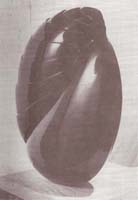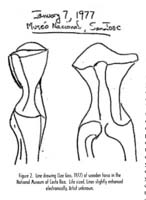One. Before 1 was 10, my family visited the California State Fair. In one pavillion was a small display of sculptures, including a wooden carving of a baby, lying on its back on a bed of gravel and sucking its toes. For months afterward 1 tried to get my toes in my mouth, before acknowledging the unequal growth of body parts that biologists call "allometric growth". For years and decades 1 imagined carving something like that, and in fact 1 still do.

Two. About 25 years later 1 visited the National Museum of Costa Rica in San Jose, where 1 saw a lifesized female torso in a tropical hardwood. As before, 1 was captivated, even stunned, and 1 lingered with the piece for a long time. This time, 1 sketched the sculpture. After returning home to Canada, 1 dreamed of it often, especially to imagine how it would feel to live in a woman's body-to move, to feel my shape from the inside, and to feel everything about my environment including other people. 1 imagined carving it, too, and kicked myself for not recording the artist's name.
Three. After another 15 years, a Costa Rican friend who was preparing to visit home asked if she could bring me anything. 1 said 1 would like a log of cocobolo, thinking it would be a miracle if 1 got it. While in Costa Rica, she arranged to meet Jose Sancho, a sculptor her mother had done some translating for, and he agreed to help. They visited a campesino who had cocobolo on his finca in the mountains, and paid him $100 US for the section of log she brought home to me. (I still have this gorgeous piece of rosewood, which is so dense that it sinks in water. So does the piece of Asian rosewood that 1 brought home from Laos last year.) 1 wrote Sancho a letter of thanks, enclosed my sculpture brochure, and thought that would be the end of it.
Four. After another five years 1 revisited Costa Rica to study hummingbirds in the rainforest. While visiting friends in San Jose 1 met a woman who knew Jose Sancho. She arranged for me to meet him, and took me to his home and studio, both of which are incredibly beautiful (there are no fir, no pine, no spruce in the tropics-only hardwoods of the richest colours you can imagine). Our mutual friend introduced us and left, and we began trying to communicate. Sancho speaks no English and my Spanish is horrible. After a while, he understood that 1 am a Canadian sculptor and scientist who studies hummingbirds, and who knows about his work. All of a sudden his face lighted up with recognition, he said, "Uno momento!" He ran into the house and up the stairs. He returned immediately with the card that I had sent him five years earlier!
Gradually we came to know each other a little, and although I can't be sure of this because of the language problem, I think Sancho told me that he had carved the torso that had stunned me in the National Museum in 1977! When I left I took with me not only an incredible experience of a man, the place where he lives and works, and his work. I also took a whole handful of handsome brochures, in one of which is inscribed in fluid handwfltmg: "Para el amigo, cientifico y escullor, Lee Gass, como recuerdo de Sll amable visita a mi taller. (Signed,) Jose Sancho. Escazu, Costa Rica. Julio de 1993."
Five. Until he quit to sculpt full time, Jose Sancho was a university economist. His first pieces, done while he was still working at the university, were welded and painted constructions of found pieces of metal. They are interesting and well-executed, but his carvings are a horse of a different colour. They are something else again, because nearly all of about 50 of Sancho's wood and stone carvings that I know of really grab me. They grab me on many levels at once, and in many ways, and invite me in. I come willingly into Jose Sancho's sense of form, and into his remarkable ability to subtract exactly the right material from a rock or from a tree to manifest his imagination in the material. What he imagines is a clear window into life, in my opinion, not just as it is in the moment, structurally, but as it is lived in real time, in the forests and fields of Central America. I have seen his work with my eyes. I have touched his pieces, some of them anyway, and when I did I was amazed. Most of his pieces are at the same time abstract in a deeply geometric sense and true to life. They are true to life both as I live it and as I understand it, as a biologist, to be lived. I love his work. It pretty much blows me away. Some of Sancho's pieces make me laugh. For example, the very large white marble piece on his front lawn. At first glance it is just a large, lovely forman abstraction. After a moment, though, it becomes clear that Sancho has carved a lifesized portrait of two polar bears mating!

Because I didn't ask Sancho's permission to share his work with you, I will show you only one sculpture (Figure I on page 8). You are welcome to sit in my living room, eat delicious Ice cream made from the produce of my small city lot, look at the pictures all you want, and even read his book if your Spanish is good enough. Or maybe, if you are good and the cow doesn't kick over the milkbucket, you'll get to see a real Jose Sancho sculpture some time. For now, then, I will leave you with a translation of part of what Sancho wrote in 1983: "My cult is the Universe, my faith is the art that redeems, my devotion is music, my priesthood is sculpture; the workshop is my refuge. These are the reasons for which I create art."

